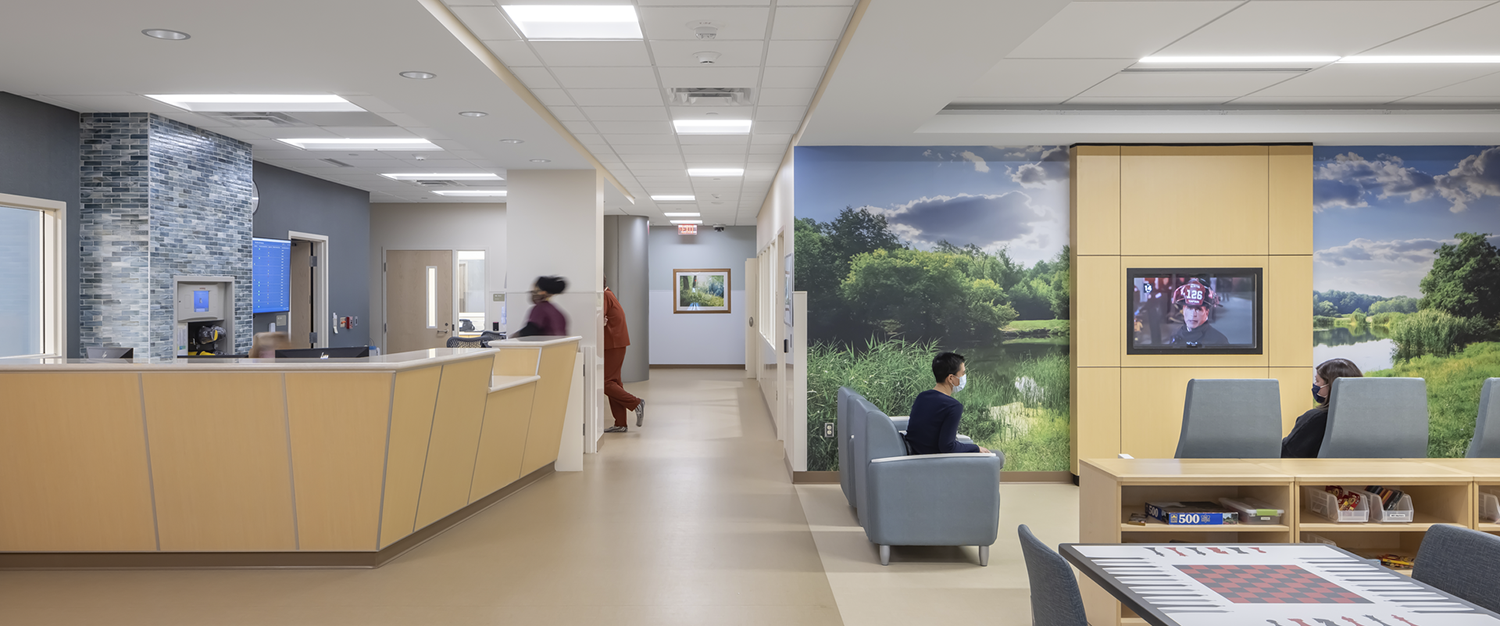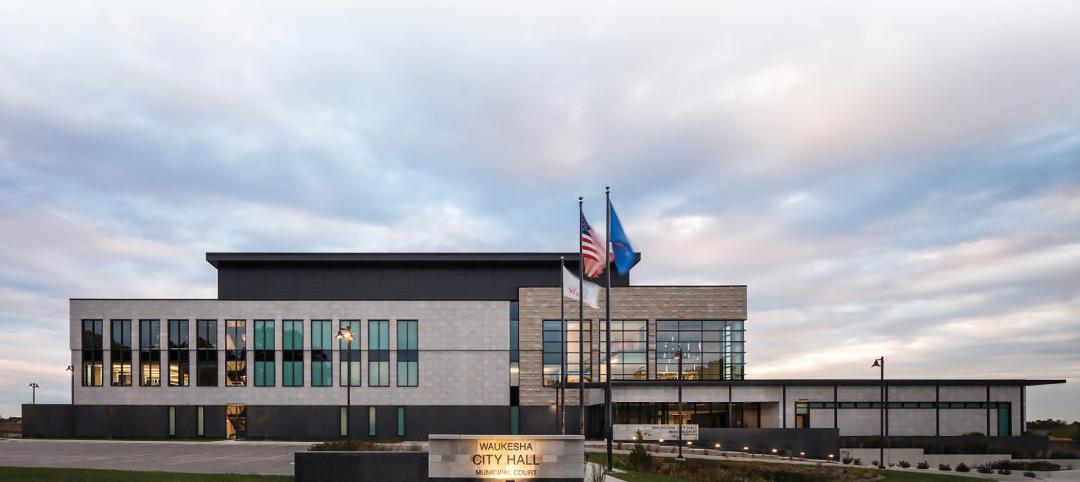We’re in the middle of a mental health care crisis. Needs are on the rise. At the same time, there’s a severe shortage of mental health professionals. The number of mental health beds are declining. The emergency department (ED) is the de-facto front door for behavior health crises, and yet these departments are understaffed, overwhelmed, and ill-equipped to navigate the layered complexities of highly demanding physical and behavioral health needs.
There are two sides to this problem: providing care, and designing to facilitate that care. That’s why a holistic approach is so important and why we see so much power in a combined perspective — “we” being Melanie Baumhover, AIA, LEED AP, BWBR principal and behavioral health design specialist, and Melanie Gullixson (yes, two Melanies), an RN, BSN, and patient care manager at Allina Health with 30 years of health care experience.
Recently, we were fortunate enough to sit on a panel called Exploring Facility Models for Emergency Mental Health at the 2022 ASHE Annual Conference alongside Scott Holmes, BWBR principal specializing in medical planning, and Devan Swiontkowski, BWBR project planner. Our goal? To address the very real, high-stakes challenges facing the behavioral health industry and how design can help.
Right now, it’s estimated that one in eight patients showing up to the ED is there with a mental health-related need. That number is increasing. In addition, it’s estimated that at least one in four people in the U.S. population face a mental health issue, so that means that at any given time, at least 25% — and likely more — of the people in an ED waiting room are facing complex, layered issues that may include both physical and mental health needs.
AN EMERGENCY IN THE EMERGENCY DEPARTMENT
As Melanie Gullixson knows all too well, mental health-related visits to the ED were already on the rise well before the pandemic, with the Agency for Healthcare Research and Quality reporting a 44% rise between 2006 and 2014. Any ED professional can attest that things have only become worse in the wake of the pandemic. Alarmingly, during those same pre-pandemic years, the number of patients arriving at the ED with suicidal ideation rose an astonishing 415%. Again, imagine what those numbers are like now.
Emergency departments are designed with critical, physically oriented medical care in mind. They’re meant to fit as many people in as efficiently as possible, with as much relevant medical equipment as accessible as possible. The problem: that setup is in direct contrast to the most urgent needs of many people in mental health crisis. EDs are flooded with the exact triggers and risks that should typically be avoided in mental health emergencies, including crowding, overstimulation, and potential access to sharp objects, medications that may be used inappropriately, and ligature risks.
And it’s not only patients who are at risk in this environment. The health care sector is one of the most dangerous sectors for employees in the U.S. Health care has the most nonfatal occupational injuries, and in the case of mental and behavioral health, there is a significantly increased risk of violent events for psychiatric staff compared to other populations.
Even when a space is designed to care for people in mental health crises, the default approach for generations may in fact make things worse. In light of the safety risks to both patients and staff, health care design for people in mental health crisis tends to be cold, punitive, isolating, institutional, fear-based, and oriented toward extreme security (think: nurses’ stations behind walls with plexi-glass blocking all contact).
Mental health crises demand a unique combination of mental, emotional, and physical health support and that demands tremendous resources. But smart, thoughtful, intentional design can provide tremendous return on investment in staff safety, patient outcomes, and patient satisfaction. That’s where our paths collide, and where we think we and our colleagues can make a real difference.
DESIGNING FOR HEALING
As Melanie Baumhover can attest, for spaces designed for mental health care, the default approach is confrontational and cold. Intentional design, on the other hand, is inviting and promotes appropriate choice and control. Yet intentional design in mental health care is not without its challenges. How do you maintain patient privacy and safety without creating an alienating space? How do you mitigate risk to staff while presenting the staff as approachable?
Some of the solutions those of us at BWBR have used in our work include incorporating color, texture, artwork, and natural light; providing sensory rooms; utilizing furniture such as bookcases to reduce the perception of crowding; and blending open spaces with a sense of personal space. Research suggests that elements aimed at reducing stress and aggression among patients experiencing a mental health crisis can improve safety for both patients and staff. A cold, institutional space might appear safer, but it can be incredibly triggering.
One promising trend we’re seeing is design that optimizes space and outcomes for people with layered needs. Providing a dedicated mental health patient room might be ligature-resistant and promote a healing environment specifically for those in mental health crisis. A flex room might be suitable for a person facing a physical or mental health crisis and might have locked cabinets or rolling partitions that can be pulled down to mask triggering elements and equipment. A great benefit of the flex rooms is they provide flexibility to staff when they have a census that flexes, or in rural areas where they just can’t have dedicated spaces for one patient type.
These flex spaces also make sure that physical needs can be met if the layered issues necessitate it. A co-located space is ideal for someone who might be experiencing a long-term stay. It’s more like a private studio apartment instead of an institutional room, with a window to the outside, a desk, and a dedicated toilet. Because it is not uncommon for mental health patients to end up boarding in the ED for days, weeks, or more, providing compassionate accommodations while staff look for safe discharge to another facility is so important.
Specialized emergency psychiatric assessment, treatment, and healing (or EmPATH) design is arguably the most exciting and impactful trend emerging. With EmPATH models, an individual arriving at the ED with a mental health crisis will be medically cleared in the ED but then promptly taken to an open, specialized area. With this approach, patients can start treatment, therapy, and applicable medication right away.
Patients and staff are less likely to be injured when design elements allow care to occur in the safest area in the facility, and patient flow is optimized to promote healing, allowing patients to return home sooner. They’re typically able to stay for up to 24 hours, but with prompt and appropriate treatment, many are discharged earlier, at which point they’re connected with relevant resources for ongoing care. Initial results indicate that the EmPATH model produces much lower rates of hospitalization compared to non-EmPATH models, reduces crowding in the ED, and can improve patient outcomes and satisfaction.
FINAL THOUGHTS
While these are complex social problems without easy answers, we are hopeful for the future of mental health care design. By taking fairly simple steps like facilitating daylight for both patients and staff, providing sensory and retreat spaces, and offering a sense of control to patients who feel they can control very little, we can promote care models that treat patients instead of simply holding them. And by incorporating a holistic view that centers this kind of intentional design, we can provide empathetic patient care that makes a real difference.
More from Author
BWBR | Oct 9, 2024
How healthcare operations inform design
Amanda Fisher, Communications Specialist, shares how BWBR's personalized approach and specialized experience can make a meaningful impact to healthcare facilities.
BWBR | Sep 9, 2024
Exploring the cutting edge of neuroscience facility design
BWBR Communications Specialist Amanda Fisher shares the unique considerations and challenges of designing neuroscience facilities.
BWBR | Jun 20, 2024
How student housing developments are evolving to meet new expectations
The days of uninspired dorm rooms with little more than a bed and a communal bathroom down the hall are long gone. Students increasingly seek inclusive design, communities to enhance learning and living, and a focus on wellness that encompasses everything from meditation spaces to mental health resources.
BWBR | May 23, 2024
The unique design needs of Critical Access Hospitals
BWBR healthcare principals Brad Krump, AIA, and Scott Kirchner, AIA, discuss their industry experience and passion for supporting the role that critical access hospitals play in their communities.
BWBR | Mar 8, 2024
Conference room design for the hybrid era
Sam Griesgraber, Senior Interior Designer, BWBR, shares considerations for conference room design in the era of hybrid work.
BWBR | Jan 30, 2024
The practical magic of the design process
Designers bridge very different worlds, and there can be an air of mystery about the process and the various roles within it. We invited some of the BWBR team to clear things up.
BWBR | Aug 10, 2023
The present and future of crisis mental health design
BWBR principal Melanie Baumhover sat down with the firm’s behavioral and mental health designers to talk about how intentional design can play a role in combatting the crisis.
BWBR | May 24, 2023
The future of work: What to expect in 2023
While no one disagrees that the workplace has undergone tectonic changes, it is less clear how to understand these shifts and synthesize them into practical action for the coming year.
BWBR | Apr 6, 2023
Design for belonging: An introduction to inclusive design
The foundation of modern, formalized inclusive design can be traced back to the Americans with Disabilities Act (ADA) in 1990. The movement has developed beyond the simple rules outlined by ADA regulations resulting in features like mothers’ rooms, prayer rooms, and inclusive restrooms.















